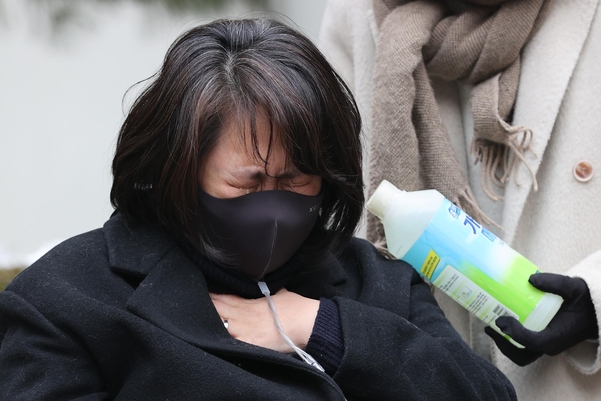Input 2021.01.12 21:27 | Revision 2021.01.12 21:47

The 23rd Department of the Criminal Agreement of the Seoul Central District Court (Deputy Judge Yoo Young-geun) pleaded guilty to 13 people, including CEO Hong and Aekyung Industrial CEO, who were accused of negligence and manslaughter on the 12th, saying, “CMIT/MIT ingredient humidifier disinfectant abolished. It is difficult to say that it has been proven to cause disease or asthma.”
According to the ruling, the judgment was based on the fact that the results of several experiments failed to prove human harm. Earlier, the prosecution submitted a report on the results of an experiment to prove the adverse effects of CMIT/MIT on the human body, and an in-depth witness newspaper was conducted on the doctors and scientists who wrote the report in court.
First of all, the Korea Centers for Disease Control and Prevention said that PHMG was clearly harmful through the experimental results. However, the CMIT/MIT component did not have any results to support the results of lung disease.
The Korea Environmental Industry & Technology Institute also conducted a preliminary test of 833 times the recommended dose, but said that no histological changes were observed in the lungs and nasal cavity. However, it should be noted that in the evaluation of disease exacerbation effects in the acute pulmonary inflammation induction model and pulmonary fibrosis induction model, “CMIT/MIT was followed after inducing acute pulmonary inflammation by administering a substance that induces pulmonary fibrosis to 24 rats. When exposed to 277 times the recommended amount, the severity of lung fibrosis was relatively increased. Accordingly, the court judged that “it is difficult to conclude that the exposure conditions are too harsh and cause lung fibrosis.”
In the inhalation toxicity test for CMIT/MIT conducted by the National Institute of Environmental Sciences under the Ministry of Environment, inflammation and fibrosis in the lungs were not observed. However, the judge said, “Some changes related to inflammation were observed in the nasal cavity, larynx, and trachea corresponding to the upper respiratory tract,” and evaluated as “the effect on the lungs is weak.”
According to the report “Toxicology Test to Identify Health Damage of Humidifier Disinfectants”, which the Ministry of Environment provided to the prosecution in January 2019, it was revealed that animals (such as rats) exposed to vapors mixed with trace amounts of CMIT/MIT suffer from respiratory diseases. Based on this report, the prosecution conducted a full-scale investigation, including seizure and search for SK Chemicals, which made humidifier disinfectants through CMIT/MIT, and Aekyung Industrial, which distributed them, and arrested some suspects.
It was judged that no significant results were found in the epidemiological investigation results. The Justice Department said, “As a result of an epidemiological investigation conducted by the Centers for Disease Control and Prevention in 2011, it was concluded that humidifier disinfectant was the cause of lung disease of unknown cause, but no case was confirmed to use a disinfectant based on CMIT/MIT among the epidemiological investigation patients.” .
The judiciary judged that the causal relationship was not confirmed even in studies related to asthma, but only to confirm the degree of association. I also heard that Mr. A, the research director, attended the court and testified with the intention that “it is difficult to conclusively conclude that CMIT/MIT will cause asthma in humans or worsen existing asthma.”
The Ministry of Environment’s comprehensive report also pointed out that it is only a kind of’opinion’, saying, “It is an opinion of experts on existing research results that have not proven causality.” It was said that a causal relationship could not be admitted on the basis of this presumption in a criminal trial demanding that the causal relationship be proved without a reasonable doubt.
However, it is pointed out that inside and outside the legal world, it is “nonsense” to judge the extent of human damage based on the results of experiments on rats.
Since rats and humans have different mechanisms, it is important that inflammatory reactions appear in themselves, and it is a criticism that the scope of the causal relationship has been judged too narrowly to see that lung fibrosis must occur in rats to adversely affect humans. In fact, the prosecution said that it would appeal immediately after the judgment of the first trial on the day, saying, “We overlooked the difference between the animal test results and the human damage.”
An attorney in Seocho-dong, who has been in charge of lawsuits related to chemical damage, said, “You should not dwell on the rat experiment, but the judgment by the court is very unfortunate.” “Isn’t the damage that appears to the human body, whether inflammation or anything, is the most important evidence? Unless you do it, how do you determine the causal relationship?”
In the future appeal trial trial, it seems to be an issue to what extent the causal relationship will be recognized for the experimental results. Another attorney in Seocho-dong said, “We cannot rule out the possibility that the judiciary ambushed the test results and the testimony of the researchers.”
In the previous Oxy representative case 3 years ago,’Lung Fibrosis’ was found as a result of PHMG’s animal inhalation toxicity test, but this CMIT/MIT-related experiment shows only inflammation in that it is different.
The judge said, “PHMG and CMIT/MIT are substances that have a completely different structure as a chemical product and a biocidal mechanism as a disinfectant,” and said, “The criterion for acknowledging the damage of humidifier disinfectant is derived from the damage case of PHMG-based humidifier disinfectant, and the material properties are quite different. “It may not be appropriate to apply it as it is to an ingredient humidifier disinfectant.”
